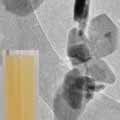Elon Musk blew our minds when he suggested that it’s highly likely we’re all living in a computer simulation. Seriously? Why would he think this, and how could we tell if it’s true?
Nice breakthrough.
Solution-processing methods are used to synthesize metal-oxide nanoparticle suspensions and thus realize efficient and stable devices.

Interfacial contact layers (ICLs) are thin films of semiconductors that can be inserted between the active organic layers and electrodes of organic photovoltaics (OPVs) to significantly improve the performance and stability of the devices. There are two types of ICL: hole transport layers (HTLs) and electron transport layers (ETLs) that require high-work-function p-type and low-work-function n-type semiconductors, respectively.1 As a result of these work-function requirements, a high built-in potential is established across the active layer of the OPV.1 In addition, specific carrier types can be chosen to reduce the amount of recombination in the devices (i.e., to block the minority carriers).1 To minimize losses from contact resistance and absorption, ICLs therefore need to be good electrical conductors and to be transparent to visible light.
Spider silk is well-known for its unusual combination of being both lightweight and extremely strong—in some cases, stronger than steel. Due to these properties, researchers have been developing spider-silk-inspired materials for potential applications such as durable yet lightweight clothing, bullet-proof vests, and parachutes.
But so far, the acoustic properties of spider webs have not yet been explored. Now in a new study, a team of researchers from Italy, France and the UK has designed an acoustic metamaterial (which is a material made of periodically repeating structures) influenced by the intricate spider web architecture of the golden silk orb-weaver, also called the Nephila spider.
“There has been much work in the field of metamaterials in recent years to find the most efficient configurations for wave attenuation and manipulation,” coauthor Federico Bosia, a physicist at the University of Torino in Italy, told Phys.org. “We have found that the spider web architecture, combined with the variable elastic properties of radial and circumferential silk, is capable of attenuating and absorbing vibrations in wide frequency ranges, despite being lightweight.”
Many bacteria possess molecular spear guns, which they fire at enemies and rivals, thus putting them out of action. The tips of these nano-spear guns, known as Type VI secretion system (T6SS), are loaded with toxic molecules that lead to death of their adversaries. However, sometimes close related bacteria come under fire. The team of Prof. Marek Basler, infection biologist at the Biozentrum of the University of Basel, has shown for the first time, that in contrast to their enemies the harpooned sister cells actually profit from the attack: After a T6SS injection, they are able to reuse specific proteins to produce their own spear guns. Thus the related bacterial strains help each other to enlarge their arsenal of weapons and to fight their competitors.
Bacteria harpoon their opponents — and their allies.
The T6SS is firmly attached to the bacterial cell envelop. The tiny spear with a sharp tip is surrounded by a flexible sheath. “When bacteria fire their spear guns, the sheath rapidly contracts in just a few milliseconds and ejects the spear out of the cell into by-standing bacteria,” says Basler describing the mechanism. “The attackers then recycle the harpoon proteins remaining in the cell.” In this maneuver, the bacteria also hit related bacterial strains that do the same as the attackers: They disassemble the harpoon into their protein components and reuse these for new T6SS assembly.